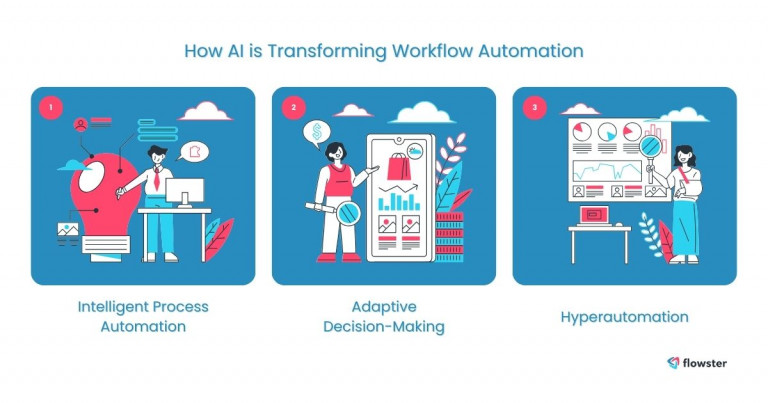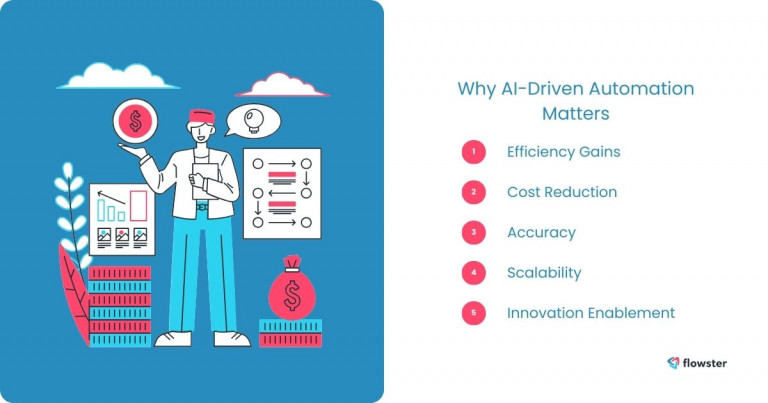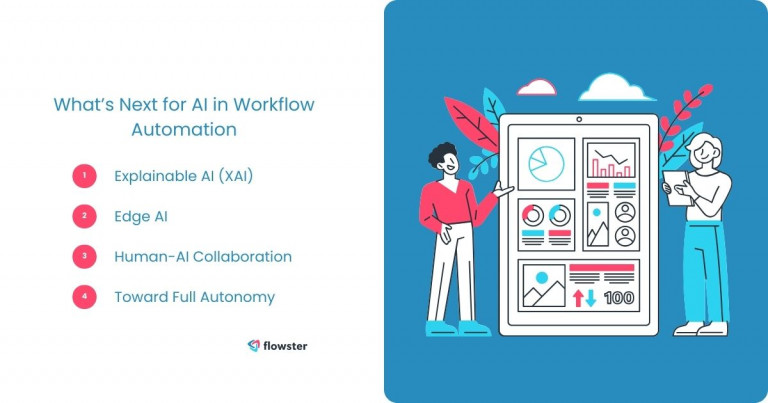Imagine a supply chain that predicts delays before they happen and reroutes shipments automatically—or a customer support system that understands questions, solves problems, and even learns from each interaction. That’s not science fiction anymore. It’s just another day with AI in workflow automation.
AI is revolutionizing how businesses operate. From streamlining repetitive tasks to enabling smarter decisions in real time, it’s transforming static processes into dynamic, self-improving systems. As we dive deeper into this shift, we’ll explore how AI boosts efficiency, brings adaptability, and reshapes the way humans and machines work together.
Article Outline
From Scripts to Smarts: The Evolution of Workflow Automation
Automation of workflows has advanced significantly. What started as rule-based scripts is now being replaced by intelligent systems that can learn, adapt, and optimize over time. This section walks through how we got here and why it’s such a game-changer.
Pre-AI Era: Rigid, Rule-Based Systems
Back in the day, automation was mostly about hard-coded instructions. Think robotic process automation (RPA) with strict rules—great for structured data but terrible at handling exceptions. These systems were limited in flexibility and struggled to scale as complexity increased.
AI Emerges: From Static to Dynamic Workflows
The real shift began when machine learning, natural language processing (NLP), and other AI technologies entered the scene. Suddenly, automation wasn’t just about repeating tasks—it was about understanding, adapting, and improving. AI in workflow automation made it possible to parse human language, recognize patterns, and even generate content on the fly.
This leap has fueled massive growth. According to a recent report, the global workflow automation market is expected to grow from USD 29.93 billion in 2025 to a staggering USD 546.82 billion by 2037, with a compound annual growth rate (CAGR) of 26.7%.
And the momentum doesn’t stop there. A recent survey shows that by 2025, 92% of executives expect their workflows to be digitized and enhanced with AI-enabled automation.
This shift is more than just a tech upgrade. It signals the dawn of a new era—one where businesses can adapt in real time, scale effortlessly, and deliver faster, smarter outcomes. It also sets the stage for emerging workflow automation trends and advanced workflow automation capabilities that will define the future of work.
The evolution is just beginning.
Flowster's AI-Driven Automation
The New Reality: How AI is Transforming Workflow Automation
AI is no longer an add-on; it’s the brain behind modern automation. In this section, we explore how AI in workflow automation is reshaping the landscape through real-world capabilities and industry-specific applications.
Intelligent Process Automation (IPA)
IPA goes beyond simple automation by integrating AI to make processes smarter. Using NLP, AI can now understand emails, extract insights, and even respond to customer queries. Tools with computer vision can scan and classify documents instantly.
Generative AI is also gaining significant attention. It’s being used to draft reports, generate codes, and create personalized content, reducing manual workloads dramatically.
Adaptive Decision-Making
One of AI’s standout features is its ability to make data-driven decisions on the fly. Predictive analytics helps businesses adjust proactively—think forecasting demand or spotting supply chain issues before they hit.
Process mining tools, powered by AI, can uncover hidden inefficiencies by analyzing workflows in detail. That insight leads to smarter decisions and continuous improvement.
Hyperautomation
Hyperautomation is about combining RPA with AI to automate as much as possible. It’s particularly powerful for handling unstructured data and complex decision trees that traditional automation couldn’t manage.
Low-code and no-code platforms are making the process more accessible. Now, even non-technical users can build automated solutions, accelerating innovation across teams.
Industry-Specific Transformations
Healthcare is seeing AI triage patients, analyze diagnostics, and streamline administrative tasks. It’s making care more efficient and scalable.
In manufacturing, predictive maintenance reduces downtime by forecasting equipment issues. AI also supports quality control by detecting defects with computer vision.
Retail is getting a makeover with AI-led inventory management and hyper-personalized marketing. These tools react in real time to demand and shopper behavior.
AI in workflow automation isn’t just improving individual tasks—it’s elevating entire systems. As industries embrace this shift, the focus is moving from simple automation to intelligent orchestration of work.

Unlocking the Benefits: Why AI-Driven Automation Matters
With AI at the forefront, workflow automation offers much more than just speed. This section highlights the real advantages businesses are already experiencing—and why they matter.
Efficiency Gains
AI never sleeps. AI operates continuously, completing repetitive tasks more quickly than a human could. This nonstop execution means projects move quicker, customer responses are immediate, and teams are freed up to focus on high-value work.
Cost Reduction
By automating processes that used to require manual input, companies can cut labor and operational expenses significantly. AI also reduces costly errors, keeping budgets tighter and outcomes more predictable.
Accuracy
When it comes to crunching numbers or analyzing data, AI doesn’t get tired or distracted. It minimizes mistakes in data entry, document processing, and calculations—keeping operations smooth and reliable.
Scalability
AI systems can effortlessly scale as businesses expand. Whether it’s processing thousands of invoices or managing a sudden spike in customer queries, AI handles variable workloads without losing efficiency.
Innovation Enablement
By taking over routine tasks, AI creates room for human creativity. Teams can focus on strategy, product development, and customer experience—areas where human ingenuity truly shines.
The upsides of AI in workflow automation are difficult to ignore. It’s not just about doing more with less—it’s about doing smarter, more meaningful work at scale.

Facing the Flip Side: Challenges of AI-Powered Workflow Automation
While the benefits are real, the road to successful AI adoption isn’t entirely smooth. This section unpacks the key hurdles businesses may encounter along the way.
Integration Hurdles
Legacy systems aren’t always AI-friendly. Getting AI to play beautifully with older infrastructure can require major overhauls and upfront investment. Companies often need to re-engineer workflows to fully leverage AI capabilities.
Ethical Risks
AI’s decision-making isn’t always neutral. Bias in algorithms can lead to unfair outcomes, especially when used in areas like hiring or lending. There’s also the ongoing concern around data privacy and how information is collected and used.
Job Displacement
AI excels at automating repetitive tasks, which can lead to short-term job losses. While new roles often emerge in the long run, the transition period can be tough for workers displaced by automation.
Over-Automation
Not everything should be automated. In customer service, for example, too much automation can lead to frustrating user experiences. Human nuance is still crucial in situations that require empathy, judgment, or creativity.
Regulatory Gaps
AI evolves quickly, but regulations often lag behind. Such developments can create gray areas around accountability. If an AI system makes a critical error, who’s responsible—the developer, the vendor, or the company using it?
These challenges don’t mean businesses should avoid AI in workflow automation. Instead, they highlight the need for thoughtful planning, responsible implementation, and a commitment to balancing tech with human insight.

Looking Ahead: What’s Next for AI in Workflow Automation
So, where is all of this heading? As AI continues to mature, it’s set to take workflow automation to the next level. This section dives into the trends and big ideas shaping tomorrow’s workplace.
Explainable AI (XAI)
As AI becomes more embedded in decision-making, there’s a growing need for transparency. Explainable AI aims to make these systems understandable to humans—so we know how and why a decision was made. That kind of clarity is key for trust, regulation, and accountability.
Edge AI
Instead of sending all data to the cloud, edge AI processes information locally—on devices or at the network’s edge. This method enables real-time automation in places like factories, hospitals, and smart homes. It’s faster, more private, and more responsive.
Human-AI Collaboration
The future isn’t AI versus humans—it’s AI with humans. Businesses are beginning to adopt hybrid workflows, where machines manage the repetitive tasks and humans contribute the context, strategy, and creativity. That means upskilling the workforce will be more important than ever.
Toward Full Autonomy
Long term, we’re heading toward systems that optimize and adapt entirely on their own. Think of self-healing IT systems or supply chains that reroute themselves without human intervention. It’s ambitious, but increasingly possible as AI in workflow automation becomes more advanced.
The road ahead is full of promise. By adopting the appropriate strategy, businesses can embrace innovation while maintaining a firm foundation in ethics, usability, and human-centered design.
Capture Your Processes in Minutes!
Final Thoughts: Making AI Work for Your Workflow
AI in workflow automation isn’t just a trend—it’s a complete shift in how organizations operate and innovate. From its early beginnings to today’s cutting-edge applications, AI is driving real change by enhancing efficiency, improving accuracy, and enabling scale.
However, the future doesn’t involve blindly embracing AI. It’s about using AI responsibly. That means prioritizing transparency, managing risks, and investing in people alongside technology.
Organizations that strike this balance will gain a serious edge in today’s fast-moving world. Are you prepared to witness its implementation? Try Flowster and experience how smart workflow automation can level up your business.




